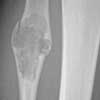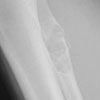Photoclinic: Pathologic Fracture of an Aneurysmal Bone Cyst
Right lower leg pain prompted a 15-year-old boy to seek medical attention. An hour earlier, he had fallen on the leg during a football game and on standing had heard a "pop." No gross abnormality was noted. Jack-Ky Wang, MD, and Laurie Meng, PA-C, of Palos Heights, Ill, report that radiographs revealed a transversing pathologic fracture through an expansile lytic lesion of the right fibula.


Right lower leg pain prompted a 15-year-old boy to seek medical attention. An hour earlier, he had fallen on the leg during a football game and on standing had heard a "pop." No gross abnormality was noted. Jack-Ky Wang, MD, and Laurie Meng, PA-C, of Palos Heights, Ill, report that radiographs revealed a transversing pathologic fracture through an expansile lytic lesion of the right fibula.
This benign, osteolytic lesion is an aneurysmal bone cyst; it accounts for about 1.5% of primary bone tumors.1 Aneurysmal bone cysts generally result from trauma that leads to disruption of blood flow to the bone; the cysts stabilize as the bone heals with progressive calcification and ossification. They primarily occur in adolescents (age range, 10 to 30 years; peak incidence, 16 years) and may be more common in females than in males. The cysts can arise in almost any bone of the axial or appendicular skeleton; the long bones and vertebrae are most often involved.
Patients with aneurysmal bone cysts may have pain and swelling.Occasionally, the cyst may be palpable. Cysts in the spine may cause compression and subsequent radicular symptoms, neurologic deficits, or paraplegia. Asymptomatic aneurysmal bone cysts may be discovered incidentally, as in this case, when a pathologic fracture through the cyst occurs.
Spontaneous regression of some cysts, mainly pelvic lesions, has been reported. Treatment depends on the location, size, and aggressiveness of the lesion and may involve either biopsy and curettage or percutaneous injections of Ethibloc (an alcoholic solution of zein [corn protein] that has thrombogenic and fibrogenic properties).2 Patients with persistent or recurrent aneurysmal bone cysts are at increased risk for pathologic fracture.
For this patient, a long leg posterior mold splint was applied. He was given non-weight-bearing crutches and referred to an orthopedist. He was subsequently lost to follow-up.
References:
REFERENCES:
1.
Martinez V, Sissons HA. Aneurysmal bone cyst. A review of 123 cases including primary lesions and those secondary to other bone pathology.
Cancer.
1988; 61:2291-2304.
2.
Cottalorda J, Bourelle S. Current treatments of primary aneurysmal bone cysts.
J Pediatr Orthop B.
2006;15:155-167.
Recognize & Refer: Hemangiomas in pediatrics
July 17th 2019Contemporary Pediatrics sits down exclusively with Sheila Fallon Friedlander, MD, a professor dermatology and pediatrics, to discuss the one key condition for which she believes community pediatricians should be especially aware-hemangiomas.